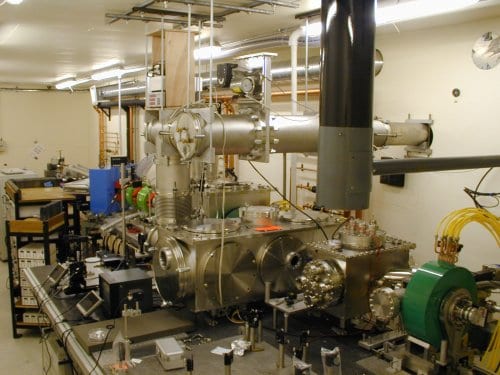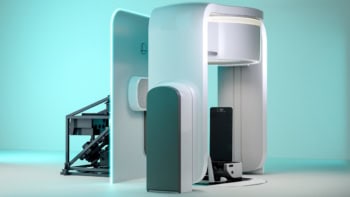
The first synchrotron radiation source small enough to fit in a university laboratory has been built in the UK. Instead of relying on a particle accelerator the size of a football field, the instrument uses a high-intensity laser to accelerate electrons to close to the speed of light. These high-energy electrons are then used to create a beam of electromagnetic radiation that could be used to study the structural and chemical properties of materials as diverse as semiconductors and living cells.
Traditional synchrotrons, like Diamond in the UK and Soleil in France, are large and costly accelerator facilities that generate high-energy beams of charged particles using electric and magnetic fields. The particles are then passed through arrays of very strong magnets – called “undulators” – which cause the particles to emit intense beams of radiation at precise wavelengths covering the terahertz to the X-ray portions of the electromagnetic spectrum.
Table-top accelerators
The ability to “dial-up” a specific wavelength by adjusting the undulators, makes the synchrotron an invaluable facility to a wide range of scientists. However, researchers have to put up with the inconvenience of having to travel to national synchrotron facilities to do their experiments – which is why some physicists are developing “table-top” accelerators that could be deployed in a typical university lab.
The most promising compact accelerator technology involves firing intense laser pulses into a plasma. As the pulse travels through the plasma, it drags nearby electrons away from the positive atomic nuclei, which creates a large electric field in the wake of the pulse. This “wakefield” can accelerate electrons to very high energies over the space of a few centimetres.
Now, Dino Jaroszynski of Strathclyde University in the UK, together with colleagues at Friedrich-Schiller-Universität in Jena, Germany, and Stellenbosch University in South Africa are the first to have combined a laser-driven plasma wakefield accelerator with an undulator to make a compact source of synchrotron radiation.
Terahertz to X-rays
The team’s wakefield accelerator can accelerate electrons to 1 GeV, which can create X-ray synchrotron radiation with a very narrow bandwidth. What’s more, the wavelength of the radiation can be tuned from the far infrared (terahertz frequencies) to hard X-rays by simply changing the energy of the electron beam (Nature Physics doi:10.1038/nphys811).
The device produces pulses of radiation that are just femtoseconds (10-15s) long, which could make it useful for studying chemical processes that occur on very short time scales.
The project is part of the Strathclyde-led ALPHA-X programme, which aims at developing laser-powered X-ray sources. The team is now working on reducing the size of the whole system. “We will start to do this by replacing the undulator by the plasma so a future synchrotron might fit in the palm of your hand,” Jaroszynski told physicsworld.com. The researchers would also like to make a “tabletop” free-electron laser (FEL) using their technique, which will be much more challenging.
“This work is very promising, and the scientific community was waiting for this kind of demonstration to show the huge potential of compact laser accelerators,” said Antoine Rouse, team leader at the Applied Optics Lab in Palaiseau, France.



